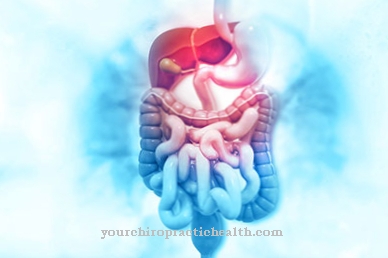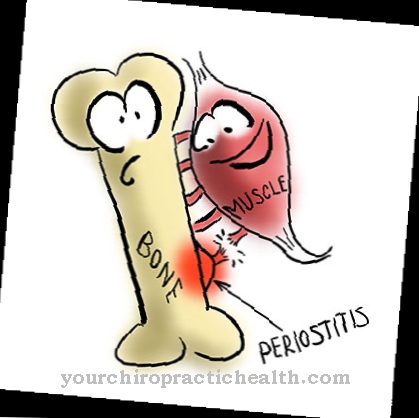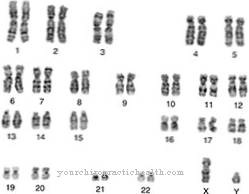As diverse as the possible causes of a Pericarditis or Pericarditis are the respective treatment options. If the chances of recovery are usually good, prevention is difficult.
What is pericarditis?

© psartstudio - stock.adobe.com
The pericardium is a tissue covering that surrounds the heart. This tissue covering is also known as the pericardium. In medicine, the inflammation of the pericardium is therefore also referred to as pericarditis.
The inflammation of the pericardium is noticeable symptomatically in the affected person, for example through severe pain below the breastbone. Often this pain becomes worse with exercise or deep breathing. In addition to pain, pericarditis can also lead to a fever.
A distinction can be made between so-called primary pericarditis and secondary pericarditis. The more common primary and the rarer secondary pericardial inflammation differ among other things in the underlying causes.
In many cases, an inflammation of the pericardium can be accompanied by a so-called pericardial effusion (i.e. pericardial effusion). This leads to an accumulation of fluid in the pericardium.
causes
There are various causes that can underlie pericarditis. While primary pericardial inflammation is triggered in most cases by viruses (in rarer cases also by bacteria), diseases that do not primarily affect the heart are responsible for secondary pericardial inflammation.
If an inflammation of the pericardium cannot be assigned a clear cause, this is also referred to as idiopathic pericardial inflammation in medicine.
Coxsackie viruses are often the cause of viral pericarditis. Influenza viruses or adenoviruses can also be responsible for pericarditis.
Bacteria that lead to pericardial inflammation often come from sources of inflammation in the body and are transported to the heart via the blood. Secondary pericardial inflammation, for example, can result from various cancers in which metastases form in the pericardium.
Symptoms, ailments & signs
Acute pericardial inflammation is most noticeable through pain in the chest and behind the breastbone, often it also radiates into the left arm, neck or back and can be aggravated by coughing, breathing, swallowing or when the position of the body is changed . Sometimes the symptoms can improve if they sit up straight and bend their upper body forward. A fever is also possible.
Other symptoms can include a faster heartbeat and irregular heartbeat. If the course is severe, chest tightness and shortness of breath can also occur. Since similar symptoms can also be signs of a heart attack or pneumonia or pleurisy, a doctor should be consulted immediately and the cause clarified.
Chronic pericardial inflammation may have little or no symptoms, or they may develop so slowly that they are overlooked for a long time. Those affected then initially only feel a general feeling of exhaustion and only develop symptoms such as an acceleration of the heartbeat, congestion of the neck veins, initially complaints during physical exertion, later also at rest and the formation of edema as the disease progresses.
Diagnosis & course
To diagnose pericardial inflammation, the attending physician usually first questions the patient about his medical history and conducts a physical examination with the stethoscope.
If an inflammation of the pericardium is suspected, an EKG can be performed and blood drawn (the latter to obtain evidence of inflammation).
In most cases, pericarditis will heal well. Especially if the pericardial inflammation is caused by viruses, healing often occurs after a few weeks. In some cases, however, complications can arise if, for example, the pericardial inflammation spreads to other structures of the heart.
Another complication is, for example, the pericardium tamponade. Here, the pressure of the pericardium on the auricles becomes so high that the blood pressure drops sharply.
Complications
Acute pericardial inflammation usually heals with correct treatment without complications. However, if the pericarditis remains untreated, life-threatening heart problems can set in. First of all, there is a risk that the inflammation will spread to other layers of the heart and lead to an inflammation of the heart muscle or the inner layer of the heart. Heart sac tamponade can also develop.
During this process, fluid collects in the pericardium and presses on the heart, which in extreme cases can lead to cardiogenic shock. Such a pericardial effusion can cause other diseases and symptoms such as bleeding or right heart failure. Chronic inflammation of the pericardium can lead to a so-called "armored heart", in which the pericardium hardens and calcifies like a capsule.
In the long term, an armored heart can lead to permanent heart damage and severely impair the heart's pumping function. In addition, permanent congestion-related kidney or liver damage can occur, which is associated with further complications.
For example, a swollen liver can lead to swelling of the legs and fluid retention in the abdominal cavity. A damaged kidney can cause high blood pressure, poisoning and other ailments. In addition, those affected are usually very exhausted and suffer from various accompanying symptoms.
When should you go to the doctor?
In any case, you should consult a doctor immediately if you experience physical symptoms such as pain on the left side of the chest and behind the breastbone, especially if you feel weak at the same time.
Especially in the case of bacterial infections or people with autoimmune diseases, there is an increased susceptibility to pericarditis. But even if there is no infection, symptoms that can indicate heart problems should always be taken seriously and be clarified by a doctor in any case.
Anyone who is quickly exhausted, repeatedly prone to fever and more often suffers from heart attack should seek medical treatment immediately because an untreated heart disease can be life-threatening. The earlier treatment starts, the better the chances of recovery.
If, in the case of a flu-like infection with fever, pain behind the breastbone and shortness of breath occur and the circulation is so unstable that there is a risk of circulatory collapse, an emergency doctor must be called immediately. In addition, in the event of breathlessness and a suspected heart attack, first aid must be provided until the emergency doctor and ambulance arrive.
Doctors & therapists in your area
Treatment & Therapy
For a successful therapy of pericardial inflammation, among other things, the diagnosis of the relevant causes is important in order to be able to treat any fundamental diseases. Regardless of the cause, an inflammation of the pericardium usually requires physical rest through bed rest. While in many cases the pericardial inflammation can be treated with medication, in some cases an operation is necessary.
If an inflammation of the pericardium has been caused by viruses, there are options for drug therapy, including the administration of anti-inflammatory and pain-relieving drugs. Symptom control is primarily possible here. If bacteria are behind an inflammation of the pericardium, they can also be fought with antibiotics.
For example, if an autoimmune disease is the basis of secondary pericardial inflammation, therapy can integrate immunosuppressive medication. If kidney failure is responsible for the pericardial inflammation, dialysis may be necessary in addition to the drug treatment.
If, for example, a pericardial tamponade occurs as part of an inflammation of the pericardium, a possible surgical measure called pericardial puncture is necessary. This drains the fluid from the pericardium, which presses on the heart chambers. If the fluid builds up quickly, it may also be necessary to insert a cardiac catheter in the course of the procedure to continuously drain the fluid from the pericardium.
Outlook & forecast
Inflammation of the pericardium can lead to premature death in the absence of medical care. The inflammation can spread to the surrounding areas in the organism and lead to a constant deterioration in health. The functional activity of the heart is considerably restricted and can lead to irregularities and failures.
If the outcome is unfavorable, there is a risk of an acute state of health, which can trigger lifelong health impairments or lead to the death of the person concerned. Surgical intervention is often necessary in an acute condition to stabilize the patient. Rehabilitation measures as well as restructuring of lifestyle must then be carried out, as the general performance of the person concerned is reduced.
With early and good treatment, the prognosis is favorable. Due to medical care and good therapy options, pericarditis heals completely in most patients. If there are no complications, the patient can usually be discharged from treatment after a few weeks as symptom-free.
With drug therapy, the pathogens are prevented from spreading and killed at the same time. The stronger and healthier the patient's own immune system, the faster healing is possible. If there are other illnesses or if the heart's function is impaired, there may be delays in recovery. However, healing is possible.
prevention
There are few ways to prevent pericarditis. If a patient is affected by repeated pericardial inflammations for which no cause can be assigned, prophylactic medication can occasionally be given in consultation with the treating doctor.
Aftercare
The cause of the inflammation of the pericardium (pericarditis) is decisive for the treatment and thus also for the aftercare. In the case of viral pericardial inflammation, the pain relievers and anti-inflammatory drugs prescribed by the doctor should be taken in the recommended amount and duration. If another underlying disease is the cause of pericarditis, its treatment is also required.
In chronic pericarditis, it is important to be sensitized to the symptoms so that action can be taken quickly when the first signs appear. In addition, a regular cardiological examination should be carried out. In principle, the prevention of infections is advisable for all forms of pericardial inflammation.
General hygiene measures, if necessary vaccinations and avoidance of further risks of infection should always be considered here. It is particularly important to refrain from any physical exertion or exercise during the healing process.
Sport and heavy physical work should only be slowly resumed after the pericardial inflammation has completely subsided and, if necessary, be suspended again if the symptoms recur.
Other activities that stress the heart, such as fatty food, smoking and a generally unhealthy lifestyle, should be recognized as risk factors and discontinued if possible. Regular heart exams should be done.
You can do that yourself
People who have been diagnosed with pericardial inflammation can support medical treatment with a few measures and various household and natural resources.
Above all, it is important to rest in bed, because recovery is optional and without complications only through rest. Those affected should also eat a healthy diet, avoid stress and ensure regular but moderate physical activity. Drug therapy can be supported by natural means. In addition to herbal teas made from chamomile or lemon balm, there are also gentle preparations made from valerian.
However, if there is severe pain in the heart area, the doctor should be turned on. In general, medical supervision is necessary in the case of pericarditis, especially in the case of previous illnesses and other risk factors.
However, certain home remedies such as warm compresses or pads can be used in most cases. After consulting the doctor, various homeopathic remedies can be tried. For example, the remedy Kalium carbonicum or “potash” has proven itself. Asclepias tuberosa or Kalmia help with sharp chest pain. If the pericardial inflammation does not subside despite all the measures taken, a further medical examination is necessary.




.jpg)



















.jpg)



